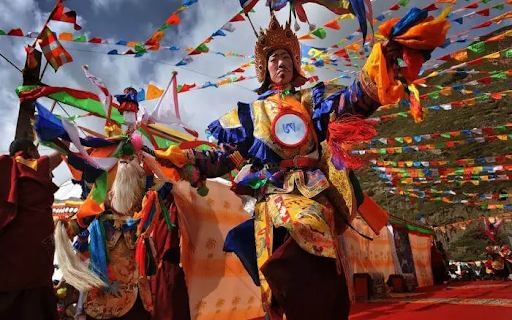Lunar New Year is celebrated differently all across the world with varying traditions and celebrations. Tibet of course has its own variation of celebrations and customs. What separates Tibet’s celebration from others is the focus on Buddhism.
To welcome the new year, a three-day festival called Losar commences, with folk dances, chants, cuisine and gifts to follow!
Day 1: Lama Losar
The festival begins on the second to last day of the lunisolar Tibetan calendar. In 2022, this will be March 3. Similar to the Chinese Lunar New Year tradition, this day is dedicated to cleaning, decluttering and tidying up the house.
 Celebrating Losar in CostumeTibetans will also make small dishes such as soup with small dumplings (mokthuk). Monasteries will be lively as people offer gifts and prayers to monks and Buddhist deities alike.
Celebrating Losar in CostumeTibetans will also make small dishes such as soup with small dumplings (mokthuk). Monasteries will be lively as people offer gifts and prayers to monks and Buddhist deities alike.
Day 2: Gyalpo Losar
As the final day of the Tibetan year begins, even larger masses head to the monasteries offering gifts to their monks. The Tibetan people wear their traditional colorful garb. Within the monasteries, celebrations begin.
 Honoring and Praying With Tibetan MonksWith a busy day of cooking ahead of them, families work together to complete their Losar feast. This dinner is also regarded as a time of reunion. Families serve delicacies such as cake (khapse) and alcohol (chang).
Honoring and Praying With Tibetan MonksWith a busy day of cooking ahead of them, families work together to complete their Losar feast. This dinner is also regarded as a time of reunion. Families serve delicacies such as cake (khapse) and alcohol (chang).
During the wee hours of the night, firecrackers and torches dance across the horizon. They ward away evil spirits and negative energy as the last day of the festival arrives.
Day 3: Choe-kyong Losar
To bring in the new year, Tibetans usually wake up early, bathe and wear new garments. To ensure good luck throughout the year, women will go to the well to bring the first bucket of water of the year home.
 Lively Dances Within the MonasteryPeople hang arrays of prayer flags upon hills and rooftops. The smell of juniper leaves and incense fill the air as families gather for their first dinner of the year. During this time, family and friends exchange gifts and money to ensure a prosperous year.
Lively Dances Within the MonasteryPeople hang arrays of prayer flags upon hills and rooftops. The smell of juniper leaves and incense fill the air as families gather for their first dinner of the year. During this time, family and friends exchange gifts and money to ensure a prosperous year.
Although the festival seems to have ended, celebrations and festivities will continue for the next two weeks.
Butter Lamp Festival
The Butter Lamp Festival (Chunga Cheopa) marks the end of the Losar festivities.
It brings a large explosion of bright yellow and red color throughout cities and towns. From alleyways to city centers, these butter candles placed throughout Tibet give an alluring view.
 An Endless Wall of Tibetan Butter CandlesRecognizing differences in how groups of people celebrate the same holidays brings communities closer. Tell us how you celebrate Lunar New Year in the comments!
An Endless Wall of Tibetan Butter CandlesRecognizing differences in how groups of people celebrate the same holidays brings communities closer. Tell us how you celebrate Lunar New Year in the comments!



0 Comments